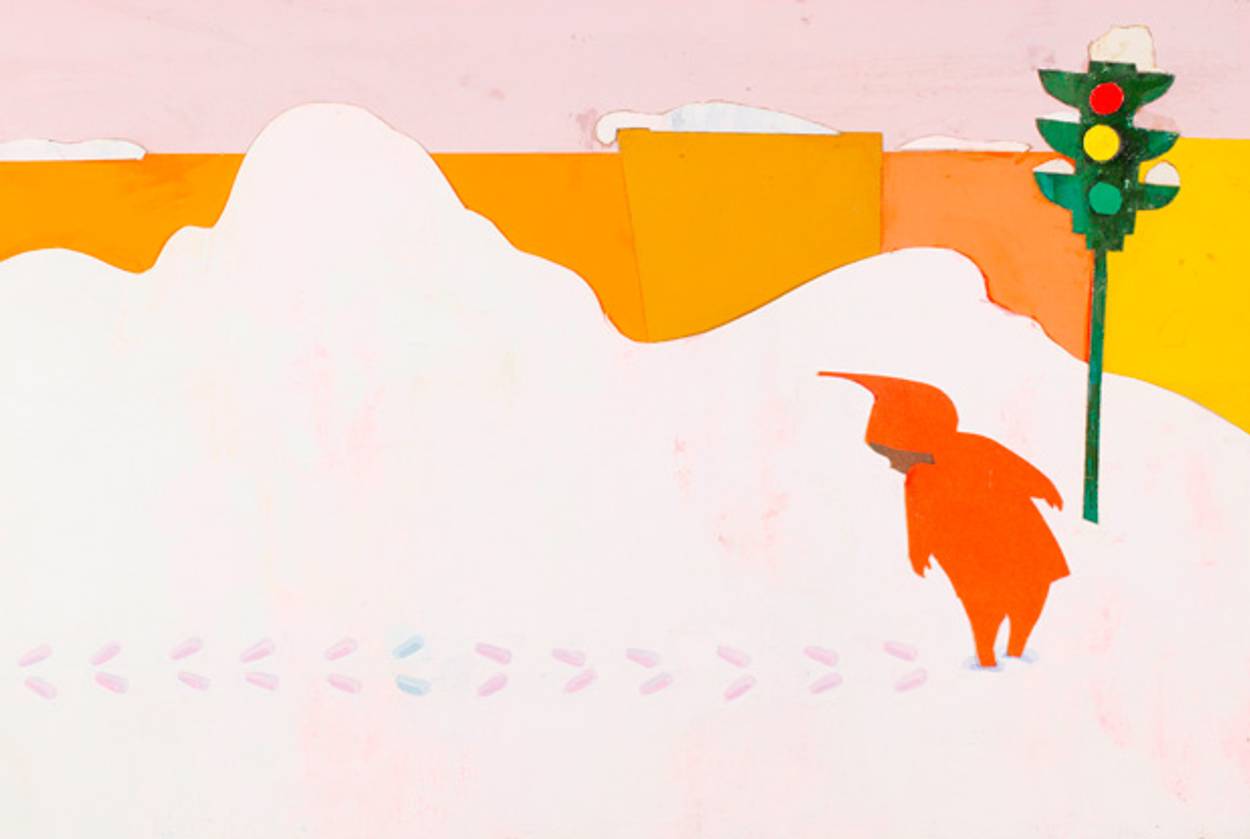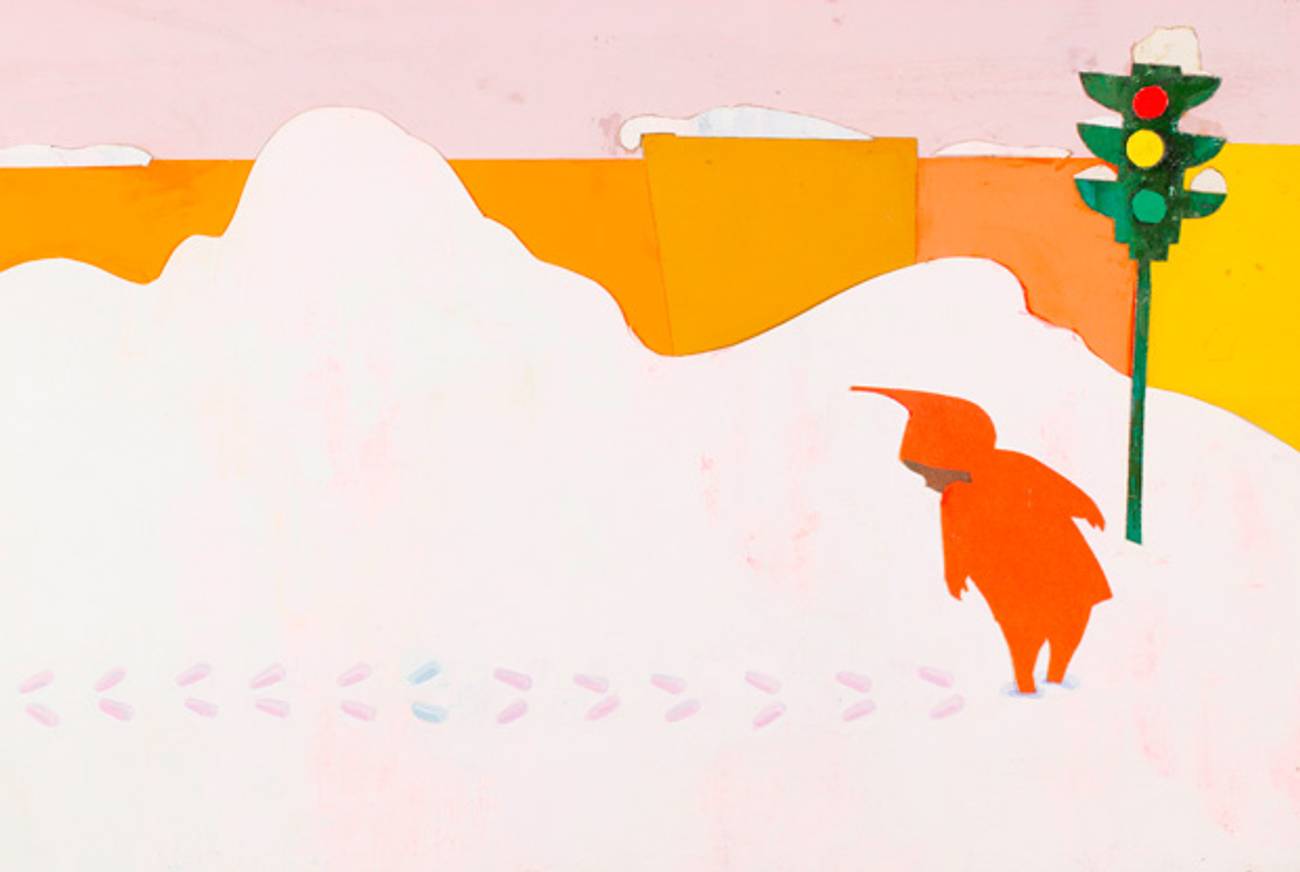Missing
An Ezra Jack Keats exhibit at the Jewish Museum underscores the children’s book author and illustrator’s striking ambivalence about his Jewishness




A stirring retrospective of the work of Ezra Jack Keats, the great children’s book illustrator and author, opened at the Jewish Museum in New York last week. Keats is well-known for his brightly colored depictions of dilapidated urban landscapes that he somehow made beautiful. He combined vibrant bits of torn paper, thick smears of rich acrylic paint in brilliant colors, handmade marbleized paper, watercolor, pencil, snippets of patterns, ripped-up text, and graffiti, all to make visual poetry. The show honors the 50th anniversary of the publication of Keats’ The Snowy Day, a Caldecott Award winner and a classic adored by generations. But when I mentioned the exhibit to people, nearly everyone had the same reply: “I had no idea he was Jewish.”
Ezra Jack Keats was born Jacob Ezra Katz in 1916. The author-illustrator of 22 books and the illustrator of more than 80, Keats created his lush scenes of beauty through his use of collage and color. His pioneering The Snowy Day is a quiet, gorgeous jewel of a book that lovingly chronicles a young African-American child’s solitary adventure during a big snowfall in the city.
When Josie was born, I received The Snowy Day as a gift. I opened it and was immediately rocketed back to my own childhood. I had loved the book’s evocation of the silence of a new snowfall, of the thrill of dragging a stick through untouched snow, the hilarity of a wad of snow falling—plop—on someone’s head. I’d loved the pattern on the protagonist Peter’s pajamas and the fact that his family seemed to have a pink bathtub. The Snowy Day was my first experience of loving art.
I’d surely noticed that Peter was black. But I easily projected myself into his experience, into the red snowsuit, into the tenement world so different from my own. When the book was published during the civil rights movement that matter-of-fact depiction of Peter as African-American was nothing short of revolutionary. It’s thought to be the first non-caricatured black hero in mainstream American children’s literature.
Sherman Alexie, the National Book Award-winning author of The Absolutely True Adventures of a Part-Time Indian, wrote of his vivid recollection of reading The Snowy Day as a child: “It was the first time I looked at a book and saw a brown, black, beige character—a character who resembled me physically and spiritually, in all his gorgeous loneliness and splendid isolation.”
“Gorgeous loneliness and splendid isolation” describe Keats’ work perfectly. Sadly, they also described his own experiences.
The artist’s parents were poor Polish immigrants who struggled to make ends meet in the hardscrabble Brooklyn neighborhood of East New York. They had little energy left for their children; Keats wrote of “walking around like a shadow,” feeling invisible.
His art became his ticket out. He received a number of scholarships, and during the Depression he found work as a muralist for the WPA. For a time he was employed as a background artist on Captain Marvel comics, and, after a stint in the Air Force, he studied painting in Paris under the GI Bill.
Keats’ work is full of African-American, Latino, and Asian characters, but he generally shied away from addressing Judaism. At first, I thought this fact made Keats an unlikely candidate for a Jewish Museum retrospective. But curator Claudia Nahson does a fine job of showing how Keats’ upbringing affected his work and his interest in social justice. Still, what I find more interesting than what’s in the show is what isn’t. Reading the exhibit’s catalog I got a fuller portrait of a man who seemed to wrestle with his ambivalence about being Jewish, projecting his experiences of poverty and discrimination onto children of other races.
He experienced a great deal of anti-Semitism—from a teacher in school, a girlfriend in Paris, and perhaps would-be employers. In the late 1940s, when he sought work as a commercial illustrator, he changed his name. His brother posited that he renamed himself because he was a fan of the poet John Keats, but his friend Esther Hautzig, author of The Endless Steppe, is quoted in the exhibit offering another explanation: “At Readers’ Digest he was advised that Keats would look better on the credits.” As to what motivated Keats, we don’t know; he never addressed his name change publicly.
Keats was friendly with Isaac Bashevis Singer, and this show includes a 1971 letter to the famed author. Keats reworded and re-edited it obsessively, marking it up with pencil, illustrating just how much he sweated over this relationship, striving to hit a relaxed but slightly obsequious tone. The letter invites Singer to consider Keats’ then-most autobiographical book, Apt. 3, a tale of brothers in a dingy, dark tenement whose world comes alive with color when they hear the music of a blind man. “It’s important to me,” Keats wrote plaintively to Singer of the book. Years later, he created illustrations for Singer’s short story “The Slave,” which focuses on Tobias, a poor Torah scribe, and his wife, Peninah. But the final result was never published, for reasons unknown. Eventually fantasy author Lloyd Alexander saw and loved Keats’ paintings and wrote a new, completely non-Jewish story for them, The King’s Fountain.
When Keats did write about religion, he sought universality rather than Jewish specificity. In 1966 he illustrated a book called God Is in the Mountain, for which he created paintings to accompany a wide array of religious quotations from the Bhagavad-Gita and the Quran to Lao-tzu to Rabbi Hillel. “I am in every religion as a thread through a string of pearls,” was one of his Hindu selections.
Universality characterizes most of Keats’ work, a development some critics found problematic, most notably in his depiction of Peter, who became a recurring character for Keats. These critics felt that Peter had little African-American identity beyond the color of his skin. Keats’ response in 1965 in a letter to the editor of the Saturday Review addressing one critic: “Might I suggest armbands?”
Keats’ books flirted with autobiography more often as he got older. His other recurring protagonist was a white boy named Louie. An artistic, socially awkward, and lonely child, Louie yearns to hold a puppet that Keats called Gussie, giving her the same name as his own emotionally distant mother, whom he recalled never giving him a hug.
Keats went to Israel in 1982, shortly before his death. In his diary, included in the exhibit, he wrote about how moved he was to place a note in the Western Wall. “I felt a strange state coming over me. … This is the city where God came to life. I felt I stood before a strange eternity.”
When Keats died in 1983, he was working on a story called “Where is God?” in which two children look everywhere for a higher being. According to the exhibit, the unpublished book concluded with one child saying, “I guess He’s everywhere.” The other child replies, “What makes you so sure God’s a He?”
Marjorie Ingall is a columnist for Tablet Magazine, and author of Mamaleh Knows Best: What Jewish Mothers Do to Raise Successful, Creative, Empathetic, Independent Children.
Marjorie Ingall is a former columnist for Tablet, the author of Mamaleh Knows Best, and a frequent contributor to the New York Times Book Review.